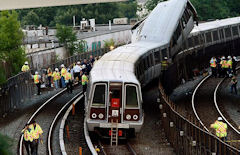In the 2000s, Loudoun County grew at a prodigious rate, averaging 6,000 housing starts yearly before the Great Recession. Construction took a dive during the recession and continues at only half the pace of a decade ago, contends Rob Whitfield with the Dulles Corridor Users Group and a long-time foe of the project. Those numbers should matter not only to home builders and local planners, he says, but to the commonwealth of Virginia, which is helping bankroll construction of Phase 2 of the Rail-to-Dulles project.
While Phase 1 would extend the Metro Silver line to just beyond Tysons Corner, Phase 2 would run it to Loudoun County beyond Washington Dulles International Airport. The economic viability of the second leg depends in part upon continued residential development in southern Loudoun. If the anticipated number of passengers doesn’t materialize, revenues could come up short — requiring even greater subsidies than acknowledged at present.
Whitfield makes a modest suggestion: Before committing an additional $300 million in state funds on top of $150 million already granted, as Governor Bob McDonnell has proposed, the state should conduct an economic analysis of the project based on current economic conditions. That is the impetus behind a bill submitted by Sen. Dick Black, R-Leesburg. SB 1361 would add a paragraph to the section of state code outlining the responsibilities of the Department of Rail and Public Transit (DRPT). Prior to funding any rail or transit project, the DRPT should provide to the General Assembly an economic and financial analysis of the proposed project:
This analysis shall include an evaluation of feasible alternatives and projected transit service demand over a Twenty year term. The analysis shall demonstrate the reasonableness of all assumptions made and provide an analysis of the impact of variables such as inflation and other economic conditions. The analyses shall be based on current market conditions and projected operating revenues, costs and replacement costs for the rail or other proposed transit project based on data prepared during the preceding three years.
As I have documented endlessly on this blog, population growth and housing development hit an inflection point during the 2007-2008 recession. In metropolitan regions across the country, growth is gravitating back toward the urban core. Moreover, growth in the Washington metropolitan region, including communities in Fairfax and Loudoun counties served by the Silver Line, are slowing. After fueling the 2000s boom in defense, intelligence and homeland security spending, Pentagon spending will level off and possibly decline outright. Population and growth forecasts for Northern Virginia have been dramatically downgraded.
The double whammy of unfavorable national and local trends will devastate population projections underpinning mega-projects from Dulles Rail to the proposed north-south corridor west of Dulles.
The only complaint I have with Black’s bill is that it applies only to rail and transit. Every mega-project should be based upon reasonably recent data. Indeed, the Commonwealth Transportation Board and NoVa regional planning authorities should go back and take a fresh look at every major transportation project, whether rail or road, slated for state funding. But, without outside prodding, they won’t. Projects build up enormous bureaucratic inertia. As a consequence, Virginia will spend billions building a transportation system for the 20th century, not the 21st.
Update: Whoops. Looks like Black withdrew his bill today! Oh, well. My logic still applies. The bill never had a chance of passing, but it would have been nice if it had inspired a little debate.



